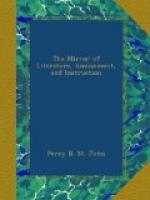In April, 1816, he sailed with three hundred men to Margarita, which island had lately again shaken off the Spanish yoke. He arrived at Juan Griego, where he was proclaimed supreme chief of the republic. On the 1st of June he sailed, and on the 3rd landed at Campano, where he beat nine hundred Spaniards. He then opened a communication with patriot chieftains, who had maintained themselves in isolated parties dispersed over the llanos of Cumana, Barcelona, and the Apure. It is a curious fact, that the isolation of several of these parties was so complete, that, for many months, they did not know of any other than themselves being in arms for the delivery of their country. It was only by their coming into accidental contact that they discovered that there was more than one patriot guerilla in existence.[3] Bolivar supplied some of them with arms, and at the same time augmented his own force to a thousand men. The Spaniards assembled in superior numbers to destroy them; but Bolivar embarked, and relanded at Ocumare, with an intention of taking Caracas: great part, however, of the Spanish army having by this time returned from New Granada to Venezuela, Bolivar was obliged to re-embark for Margarita.
[3] For the honour of the
llaneros, this circumstance ought to be
more
distinctly detailed.
In 1817, he landed near Barcelona, where he collected seven hundred recruits, and marched towards Caracas; but, being worsted in an affair at Clarines, he fell back again upon Barcelona, where he shut himself up with four hundred men, and made a successful resistance against a superior force.
Bolivar received some reinforcements from the interior of the province of Cumana, upon which he decided upon making the banks of the Orinoco the theatre of his future efforts. Having further augmented his force, and taken the necessary steps to keep alive the war in the districts on the coast, he marched to the interior, beating several small royalist parties which he encountered on his route.
Of the Spanish army which had returned from New Granada, a division, under the brave General La Torre, was destined to act against the patriots in Guayana. A division of the latter, under General Piar, having obtained a decisive victory, Bolivar was enabled to invest Angostura, and the town of old Guyana, which were successively taken on the 3rd and 18th of July.
In Angostura, Piar was found guilty, by a court-martial, of an attempt to excite a war of colour. Piar (a man of colour himself) was the bravest of the brave, and adored by his followers; but his execution stifled anarchy in the bud.
The rest of the year 1817 was actively spent in organizing a force to act against Morillo, who had lately been reinforced by two thousand fresh troops from the Peninsula, under General Canterac, then on his way from Spain to Peru. An abundant supply of arms, received from England, was sent to the patriot corps on the banks of the Apure.




